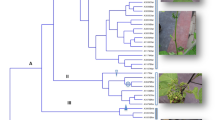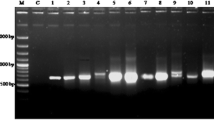Abstract
In cDNA-amplified fragment length polymorphism (cDNA-AFLP) analysis, it is critical to choose a suitable pair of restriction enzymes for tagging sites in cDNA for amplification. Possibility of production of chimeric fragments from cDNA-AFLP analysis remains to be researched. The objectives of this study were to detect an efficient restriction enzyme combination for cDNA-AFLP analysis when Festuca species was used as template, and to evaluate the identity of transcript-derived fragments (TDFs) from cDNA-AFLP analysis. We found that NspI coupled TaqI was a pair of highly efficient enzymes by generating a much higher number of TDFs than the commonly used EcoRI and TaqI. This was the first study to apply NspI for AFLP analysis, prompting that this enzyme may have valuable application potential for other species. The identity of TDF was evaluated by sequencing a TDF and comparing it with the sequence of the template cDNA. The result showed that the chimeric fragments derived from ligation between digested fragments was generated and could not be eliminated by increasing adapter concentration. Although the existence of chimeric fragments should be carefully considered, the unexpected sequence in the chimeric TDF may not seriously influence the sequencing and BLAST searching analyses.
Similar content being viewed by others
References
Donson, J., Fang, Y., Espiritu-Santo, G., Xing, W., Salazar, A., Miyamoto, S., Armendarez, V., and Volkmuth, W. (2002) Comprehensive gene expression analysis by transcript profiling. Plant Mol. Biol. 48, 75–97.
Kuhn, E. (2001) From library screening to microarray technology: strategies to determine gene expression profiles and to identify differentially regulated genes in plants. Ann. Bot. 87, 139–155.
Bachem, C. W. B., Van der Hoeven, R. S., de Brunijn, S. M., Vreugdenhil, D., Zabeau, M., and Visser, R. G. F. (1996) Visualization of differential gene expression using a novel method of RNA finger-printing based on AFLP: analysis of gene expression during potato tuber development. The Plant J. 9, 745–753.
Jones, J. T. and Harrower, B. E. (1998) A comparison of the efficiency of differential display and cDNA-AFLPs as tools for the isolation of differentially expressed parasite genes. Funda. App. Nema. 21, 81–88.
Campalans, A., Pagè, M., and Messeguer, R. (2001) Identification of differentially expressed genes by the cDNA-AFLP technique during dehydration of almond (Prunus amygdalus). Tree Physiol. 21, 633–643.
Bachem, C. W. B., Horvath, B., Trindade, L., Claassens, M., Davelaar, E., Jordi, W., and Visser, R. G. F. (2001) A potato tuber-expressed mRNA with homology to steroid zdehydrogenases affects gibberellin levels and plant development. The Plant J. 25, 595–604.
Qin, L., Oyermars, H., Helder, J., Popeijus, H., van-der-Voort, R., Groenink, W., et al. (2000) An efficient cDNA-AFLP-based strategy for the identification of putative pathogenicity factors from the potato cyst nematode Globodera rostochiensis. Mol. Plant Micr. Inter. 13, 830–836.
Bachem, C. W. B., Oomen, R. J. F. J., and Visser, R. G. F. (1998) Transcript imaging with cDNA-AFLP: a step-by-step protocol. Plant Mol. Biol. Rep. 16, 157–173.
Clayton W. D. and Renvoize, S. A. (1986) Genera Graminum. Grasses of the World. Her Majesty’s Stationary Office, London.
Aronson, L., Gold, J., and Gull, R. J. (1987) Coolseason turfgrass response to drought stress. Crop Sci. 27, 1261–1266.
Fry, J. D. and Butler, J. D. (1989) Responses of tall fescue and hard fescue to deficit irrigation. Crop Sci. 29, 1535–1541.
Qin L., Prins, P., Jones, J. T., Popeijus, H., Smant, G., Bakker, J., et al. (2001) GenEST, a powerful bidirectional link between cDNA sequence data and gene expression profiles generated by cDNA-AFLP. Nucleic Acids Res. 29, 1616–1622.
Author information
Authors and Affiliations
Corresponding author
Rights and permissions
About this article
Cite this article
Wang, J.P., Bughrara, S.S. Detection of an efficient restriction enzyme combination for cDNA-AFLP analysis in Festuca mairei and evaluation of the identity of transcript-derived fragments. Mol Biotechnol 29, 211–220 (2005). https://doi.org/10.1385/MB:29:3:211
Issue Date:
DOI: https://doi.org/10.1385/MB:29:3:211




